
Concept explainers
Each diode cut−in voltage in the circuit in Figure P2.59 is 0.7 V. Determine

Figure P2.59
(a).
The values of
Answer to Problem 2.59P
Explanation of Solution
Given Information:
The given circuit is shown below.
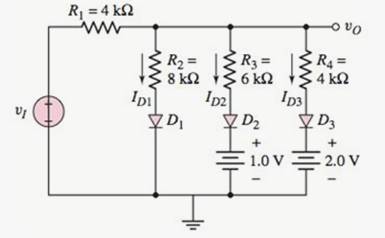
Calculation:
For
The input voltage is dropped across the output because the current in the circuit is zero.
(b).
The values of
Answer to Problem 2.59P
Explanation of Solution
Given Information:
The given circuit is shown below.
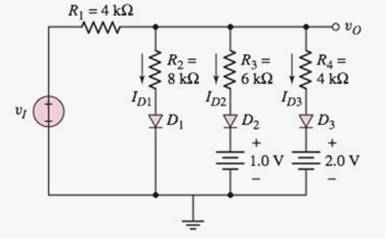
Calculation:
For
The value of diode current
The modified circuit is:
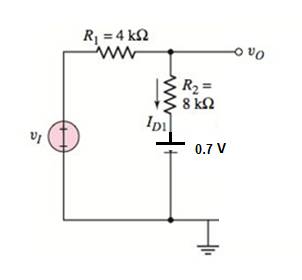
Applying Kirchhoff’s voltage law:
The value of output voltage
(c).
The values of
Answer to Problem 2.59P
Explanation of Solution
Given Information:
The given circuit is shown below.
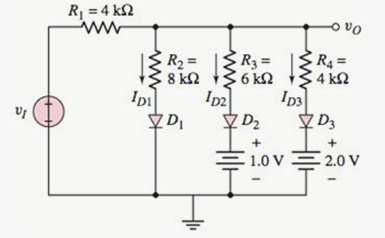
Calculation:
Assuming the diodes are in forward bias and in active mode.
Applying Kirchhoff’s current law at output node:
From above calculation diodes D1,D2 are in forward bias active mode but the diode D3 is in cut off mode because the voltage difference between positive and negative terminal is less than 0.7 V. The current through diode D3 is zero.
Hence, the assumption is incorrect.
The modified figure is:
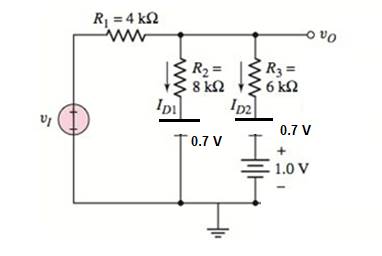
Applying Kirchhoff’s current law at output node:
The diode currents
(d).
The values of
Answer to Problem 2.59P
Explanation of Solution
Given Information:
The given circuit is shown below.
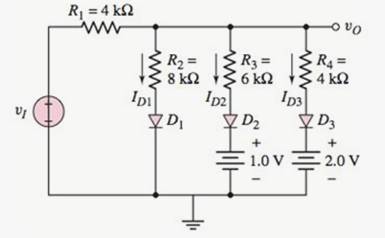
Calculation:
For
Applying Kirchhoff’s current law at output node:
The values of diode currents are:
Want to see more full solutions like this?
Chapter 2 Solutions
Microelectronics: Circuit Analysis and Design
- A Three-phase, 12 pole, Y-connected alternator has 108 slots and 14 conductors per slot. The windings are (5/6 th) pitched. The flux per pole is 57 mWb distributed sinusoidally over the pole. If the machine runs at 500 r.p.m., determine the following: (a) The frequency of the generated e.m.f., (b) The distribution factor, (c) The pitch factor, and (d) The phase and line values of the generated e.m.f.?arrow_forwardTwo 3-ph, 6.6 kV, Y-connected, alternators supply a load of 3000 kW at 0.8 p.f. lagging. The synchronou impedance per phase of machine A is (0.5+110) and that of machine B is (0.4 +J12) . The excitation of machine A adjusted so that it delivers 150 A. The load is shared equally between the machines. Determine the armature curre p.f., induced e.m.f., and load angle of each machine?arrow_forwardName the circuit below? The output voltage is initially zero and the pulse width is 200 μs. Find the Vout and draw the output waveform? +2.5 V V 247 -2.5 V C 0.01 F Ri W 10 ΚΩarrow_forward
- Please work outarrow_forwardFind Vfinal when Vs up and Vs V. Which LED will light in each case? Red or Green? Justify your answers. Fill the table below. Vs 8 ΚΩ Vos Χρι + 3 ΚΩ www 6 ΚΩ ww 4 ΚΩ Yo www Vo Vec-12 V Nol V final Vm w 3 ΚΩ 5 V 38 ΚΩ R= 1 kQ V -12 V Red LED Green LED Vs Vo Vfinal Which LED is ON? Varrow_forwardCircuits help please solve and explain. Question in images providedarrow_forward
- + V 6.2 A 1.2 A S R 4 Ω Find the source voltage Vs 0.8 Aarrow_forwardDetermine i(t) for t≥ 0 given that the circuit below had been in steady state for a long time prior to t = 0. Also, I₁ = 1 5 A, R₁ =22, R2 =10 Q2, R3 = 32, R4 =7 2, and L=0.15 H. Also fill the table. m L ww R2 t = 0 R₁ 29 R3 R4 Time 0 iL(t) 0 8arrow_forwardPlease help explain this problemarrow_forward
- + P = 16 W w w P = 8 W I R₁ R2 E = RT=322 1- Determine R1, R2, E ΙΩarrow_forward+ 30 V = - 20 V + R 2- Use KVL to find the voltage V - V + + 8 Varrow_forwardFind the Thévenin equivalent circuit for the portions of the networks in Figure external to the elements between points a and b. a R₁ 2002 I = 0.1 A 0° Xc : 32 Ω R2 = 6802 20 Ω фъarrow_forward
